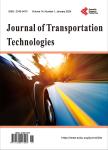Continuous Flow Intersection Performance Measures Using Connected Vehicle Data
Continuous Flow Intersection Performance Measures Using Connected Vehicle Data作者机构:Purdue University West Lafayette USA Utah Department of Transportation Salt Lake City USA
出 版 物:《Journal of Transportation Technologies》 (交通科技期刊(英文))
年 卷 期:2022年第12卷第4期
页 面:861-875页
学科分类:0809[工学-电子科学与技术(可授工学、理学学位)] 08[工学]
主 题:Performance Measures Connected Vehicles Trajectories Continuous Flow Intersection Displaced Left Turn
摘 要:Continuous flow intersections (CFIs), also known as displaced left turns (DLTs), are a type of alternative intersection designed to improve operations at locations with heavy left-turn movements by reallocating these vehicles to the left side of opposing traffic. Currently, simulation is commonly used to evaluate operational performance of CFIs. However, this approach requires significant on-site data collection and is highly dependent on the analyst’s ability to correctly model the intersection and driver behavior. Recently, connected vehicle (CV) trajectory data has become widely available and presents opportunities for the direct measurement of traffic signal performance measures. This study utilizes CV trajectory data to analyze the performance of a CFI located in West Valley City, UT. Over 4500 trajectories and 105,000 GPS points are analyzed from August 2021 weekday data. Trajectories are linear-referenced to generate Purdue Probe Diagrams (PPDs) and extended PPDs to estimate split failures (SF), arrivals on green (AOG), traditional Highway Capacity Manual (HCM) level of service (LOS), and the distribution of stops. The estimated operational performance showed effective progression during the PM peak period at all the critical internal storage areas with AOG levels at exit traffic signals between 83% and 100%. In contrast, all external approaches with longer queue storage areas had AOG values ranging from 2% to 81% during the same time period. The presented analytical techniques and summary graphics provide practitioners with tools to evaluate the performance of any CFI where CV trajectories are available without the need for on-site data collection.



